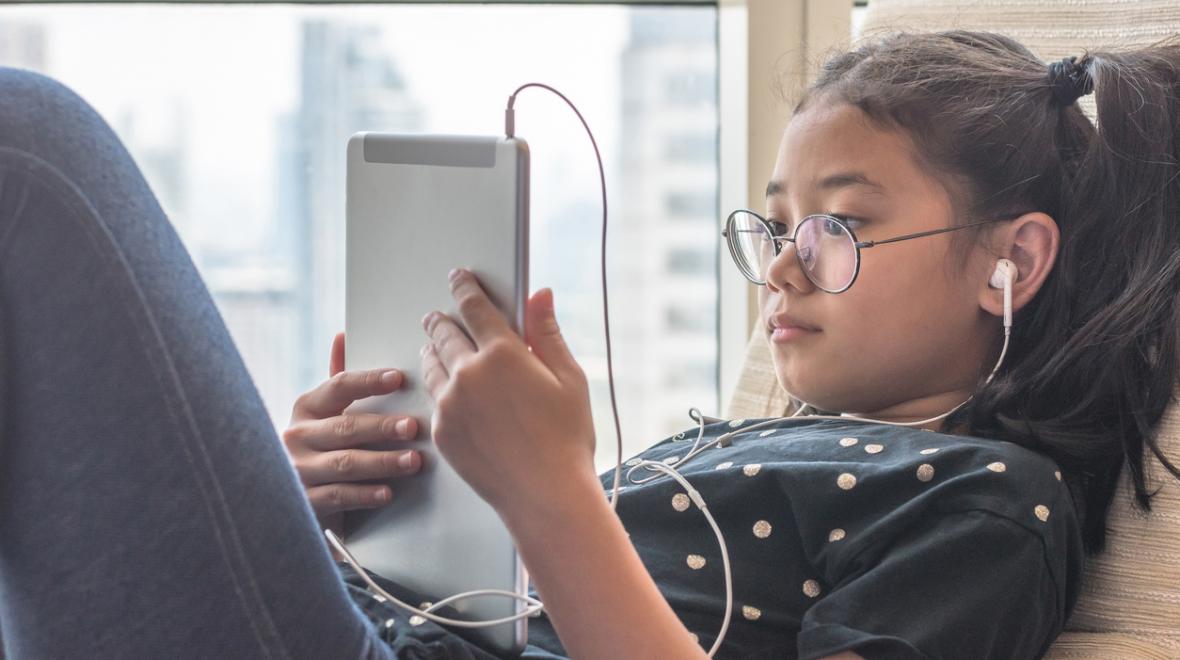
In a matter of weeks, my five-year-old daughter went from having no experience with video calls to becoming our family’s go-to expert. The other day I overheard her explaining to her teacher, “You have to mute everybody to make the echo stop.” I’m impressed but not surprised.
We’re quickly adapting to this new normal. Working remotely, we’re continuing to fulfill our job functions while leaning on technology to jump over any hurdles. As parents, we’re trying to do the same for our kids, helping them retain as much of their pre-pandemic normalcy as possible while they continue to grow. It’s not an easy task, and I’ll admit what’s helped us the most during this time: digital devices. Screens are my two daughters’ best friends right now.
At first, this realization worried me. A recent study found that children using screens more than seven hours a day are more than twice as likely to be diagnosed with anxiety or depression than kids whose daily screen time is five hours or less. Can we even keep track of our kids’ screen time anymore? I’m not the only one with these kinds of anxious thoughts. Recent PEW research shows that two-thirds of parents are concerned about their teen’s screen time — and this was before COVID-19. Now, we’re playing a different game entirely. When we think about screen time as it relates to parenting during the quarantine, it’s time we reconsider our approach.
The most important thing for your kid right now is that their current day-to-day resembles their pre-pandemic routine — as much as it can, anyways. To keep things business as usual, working parents should adapt their parenting style and use screens more. I don’t mean let your kids binge shows and play “Fortnite” all day. But the amount of screen time isn’t necessarily a problem; it’s the kind of screen time that matters most. If you’re making screen time active, you’ll be able to worry less about your child’s screen time and focus more on WFH — and crushing it.
Here’s how to get started:
Focus on results.
Since the quarantine began, Sunday nights are for lesson planning. I go through the emails my daughters get from their teachers, I look for activity ideas on social media, and I use an online doc to block out my daughters’ schedules. Setting up a structure like this helps my husband and I keep the kids engaged and entertained while we’re busy at work. It also prevents us from needing to hunt YouTube channels for a link while chaos breaks out behind us. Every event on their calendars should have a tangible outcome, and if it doesn’t, the activity gets nixed.
To keep your kid busy throughout the day, I recommend making a schedule like this. Before every activity, you should define the expected outcome of your kid’s screen usage. Ask yourself: What do I want my child to gain from this screen time? Whether it is video-calling a classmate to socialize or watching YouTube to learn a new skill, active screen time results in something gained. If there’s no outcome — think infinite scrolling on Instagram — then it’s very likely passive screen time. In which case, you should avoid it.
Doing this will help you rest — or rather work — easy knowing your kid is benefiting from active screen time.
Experiment with new flavors.
Once you’ve found an active screen-time activity that your kid is passionate about, you may feel like you’ve cracked the case. For example, I’m convinced my daughter will be the next Frida Kahlo given how much time she’s spending with her favorite drawing app. While I’m loving the results, we’re making efforts to balance her screen time across other academic disciplines such as science, technology and mathematics.
As parents, we should constantly bring new activities that encourage our children to develop new skills.
Here are some of my recent favorites:
- Strategy games like “Minecraft”: Make sure that your kid is in the driver’s seat. If they’re only watching the game, then that is passive screen time unless they’re learning how to do something new in the game.
- Online tutorials like cooking or dance classes: After your kid watches a video, encourage them to get up and put what they saw into practice! This helps them retain that knowledge better.
- Computer programming: There are plenty of ways for kids to learn how to code these days, from online classes to playing games using robots, so experiment with different methods until you find what works best.
My daughter may be an artist when she’s older; she might also be a programmer. Regardless of the path she chooses, she’ll have the skills needed for both.
Make it physical and fun.
Make sure your kids’ screen time isn’t just active, but physical, too. If your kid begins developing a sedentary lifestyle during the quarantine, that’s a habit that’s hard to break. To avoid the consequences of a sedentary lifestyle, parents can merge active screen time with hands-on play and reap the benefits of both. For every two sessions involving active screen time without physical movement, include a session that gets your kid up and moving.
That means my daughters are practicing yoga while I’m in a meeting. Or it means we’re creating a silly dance and uploading it to TikTok before lunch. These kinds of activities help my daughters think outside the box, stay active and have fun while flexing their minds.
That’s what play-based learning is in a nutshell. Play-based learning is all about using educational activities to encourage your kids to explore their imagination. Screens can facilitate their creative expression and should be used whenever appropriate.
The American Academy of Pediatrics recommends limiting kids’ screen time to one hour every day for kids ages of 2–5. In the new normal, forget about it. Using screens is the only way that working parents can maintain pre-pandemic normalcy in their kids’ lives, and that’s totally alright.
Of course, we already know what happens when we let our kids watch television all day; they become zombies. But when we provide them with the right kind of screen time — active screen time — there’s a different outcome, and it’s so much fun to watch!
Whenever I make screen time active, and my kids are chatting with their peers or learning a new skill from an online tool, they’re just as engaged as if the person on the other screen was there in the same room. Kids are already adjusting to learning virtually, so for them, there’s nothing new under the sun. It’s just a different way of doing things.











